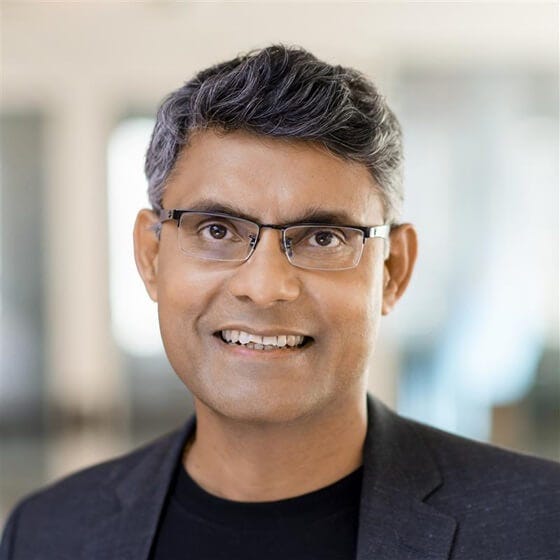For CIOs, planning for the future can mean cutting through the digital noise of shadow AI, new cybersecurity threats, and the aspirations that surround quantum computing.
While such disruptions in the IT landscape warrant attention, the CIOs from TIAA, Extreme Networks, and Akamai put into perspective some of their more immediate, tangible concerns. Where they plan to focus their attention in the coming 12 months sounds less like chasing trends and more about prepping their organizations to use modern tech — including AI — to deliver results.
Sastry Durvasula, chief operating, information and digital officer at financial services organization TIAA, says the rapid evolution and adoption of AI in recent years has added new responsibilities for CIOs and opened avenues for professional growth.
“AI, its potential, and its disruptive power, I think, has created a set of strategic opportunities for the CIO to be the front-line leader for a company,” he says.
Translating for the C-Suite
For Durvasula, who has spent most of his career in the financial services industry, and for the past 25 years has worked for companies that were often more than a century old, IT leadership is about translation. Working with such entrenched incumbents means finding ways to bridge modern tech with operations that have seen little change over the decades. With the fast pace of AI’s spread, C-suite leaders may need careful guidance to navigate these new tech frontiers.
“CIOs have such an important role at this juncture because they are the strategic advisors to the CEO, to the rest of the executive committee, and to the board,” says Durvasula.
Workforce Transformation
CIOs are also the people who connect technology transformation to workforce transformation. Given the significant emphasis on AI, Durvasula — as others have predicted — expects the workforce to be redefined by technology. He also says it will be a CIO’s responsibility to define that workforce of the future for their company — while also ensuring that the company’s culture remains intact. This includes upskilling and re-skilling colleagues, potentially through periods of anxiousness about their current jobs and future career opportunities, he says.
Reengineering Workflows, Cybersecurity’s AI Challenge
Those workforce issues intersect with his next concern, the workflows of the future in this rapidly evolving space: “How should we rewire some of the critical business workflows, operational workflows, technology workflows?”

Sastry Durvasula, TIAA
Durvasula believes new workflows, influenced by AI, could affect roles across the enterprise, from developers and managers to designers and customer-facing personnel. There will almost certainly be challenges in maintaining company culture during such a transition, and this may well represent the area where the CIO can have the most impact. “I feel like that is the biggest mandate and opportunity for CIOs,” he says.
AI is also changing the cybersecurity landscape for CIOs, Durvasula says. While AI could be a net positive for cybersecurity when applied defensively, the tech also presents significant governance and security concerns, such as impersonations, nation-state-sponsored attacks, and other new threats and attack vectors. The challenge for CIO, he says: “How do we leverage AI to make our cyber capabilities robust?”
Finally, AI may be a prominent catalyst for change, but Durvasula also keeps watch for other disruptions and prospects that could emerge. “I think that there is a new set of business opportunities, whether they are AI-powered or just more broadly fintech-powered,” he says.
To that end, Durvasula says he and TIAA look for potential strategic opportunities through TIAA Ventures, the venture capital arm of the firm, which allows them to keep a close watch on innovation that surfaces in Silicon Valley for possible investment that may expand the business into new markets.
“There is a range of opportunities, whether it’s with startups that are coming up or with the big tech and hyperscalers that are obviously innovating,” he says, pointing out the need for CIOs to bring their expertise to such engagements, to help leverage those innovations and opportunities to support the company’s model.
IT Still Must Serve Up ROI
For Anisha Vaswani, chief information and customer officer at Extreme Networks, a networking solutions provider, key priorities include supporting business strategies and goals. At Extreme, that has meant transformation projects that include app modernization and rationalization, she says. “We’re modernizing our front office; we’re modernizing our back office.”
Vaswani says there has been a shift in the CIO community mindset when it comes to AI, with curious, early experimentation giving way to thoughtful, careful investments in the technology.

Anisha Vaswani, Extreme Networks
Extreme Networks has developed its own AI-native platform, Vaswani says, but she also remains tempered by an MIT study that posited that about 95% of generative AI pilots fail. Rather than totally dismissing the technology based on the study, she wanted to better understand the positive results. “My first question was, ‘What were the 5% that were successful?’” Vaswani asked. Those successful pilots, she says, focused on solving real problems, often in domain-specific areas, rather than serving as general tools.
Modernization Remains the Name of the Game
Modernization is also front and center for Kate Prouty, senior vice president and CIO of Akamai Technologies, a provider of cloud computing and security solutions. Prouty says her organization is focused on modernization in light of legacy platforms that may still be in use. “We’re constantly making decisions about where we make technology investments based on the critical business needs for the company,” she says.
Without access to more modern platforms, she says, it could be impossible for internal teams such as finance, human resources, and procurement to make use of the AI technology being pushed by vendors to embed in platforms. “A big focus for IT is really starting to modernize these platforms,” Prouty says.
For example, she says their back-office systems are migrating legacy apps off an on-prem Oracle to Oracle’s cloud. This is being done in phases with HR first, then eventually finance and accounting to follow. “We did this purposefully because you know the finance side of the house is something that you want to be really careful about,” she says.
Wide-Net Approach to AI — with Guardrails
Prouty recognizes AI as an unavoidable challenge to work through, which led to a wide-net approach at Akamai to work with the technology while remaining cautious. That included reining in “shadow AI,” where staffers might deploy their own AI tools and leverage them in ways that might not mesh with company guidance and guardrails. “The good news is we saw this one coming and wanted to make sure we avoided that,” she says.
Akamai went through a process of assessing and optimizing its third-party spending on cloud, Prouty says. This led to a lesson of not wanting to discourage staffers from experimenting with tech-driven ideas, but also needing oversight on how technology is used within the company. That means use cases must be run through IT first, she says, to guide the use of the tech, conduct security reviews, and check for redundant tools.

Kate Prouty, Akamai Technologies
Though vendors are eager to get AI tools on the market, Prouty says in many cases the tech is just not mature enough yet. “Vendors are clearly trying to go to market as fast as they can,” she says. Some AI tools may not yet offer significant benefit to the populace, she says, plus there can be a training component. “We’ve got this AI tsunami coming at us, and we’re trying to maintain healthy, good operating margins.”
Transformation for Akamai is not strictly AI, Prouty says, as modernization focuses on productivity and user experience improvements. “It’s about consolidation of a hodgepodge of SAS apps, in some cases, that we’ve collected along the way.” Niche solutions that were once considered best of breed have been consolidated to Oracle’s cloud, she says.
There are technologies in development that have Akamai’s attention that do not call for immediate focus — at least for the moment.
“In terms of quantum, as a company, that is something on Akamai’s radar,” Prouty says. “As a CIO, it is not on my radar. I’ve got many more near-term things to worry about.” She says they have a strategy to develop staffing — including upskilling — and other resources the company has that may have a more immediate impact.






